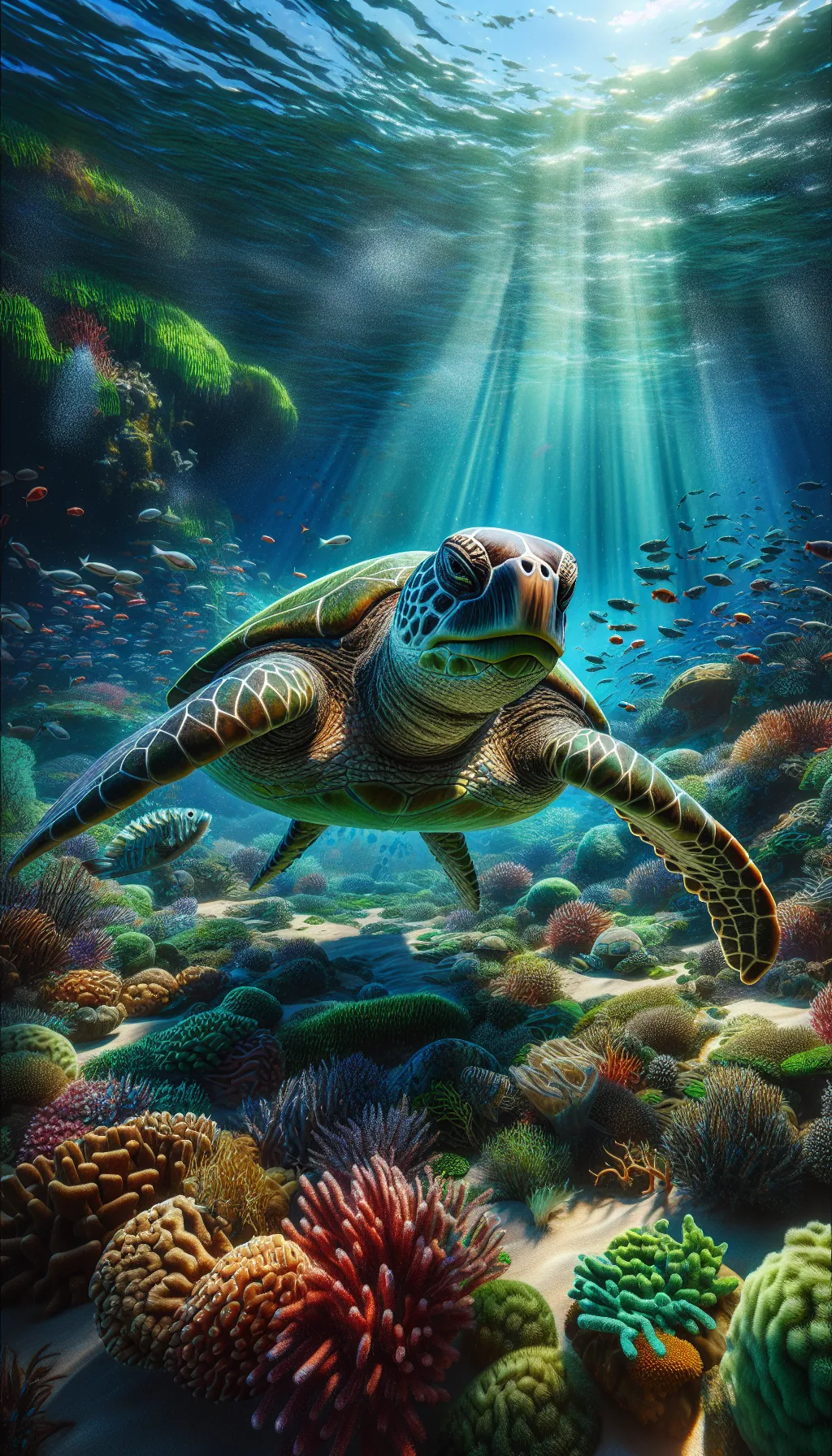The Green Sea Turtle
The Green Sea Turtle, also known as Chelonia mydas, is a large marine reptile with a smooth, olive-colored carapace and a yellowish plastron underneath. They are known for their herbivorous diet, primarily feeding on seagrasses and algae. Green Sea Turtles have a distinctive pair of scales in front of their eyes and can weigh up to 700 pounds.

| Green Sea Turtle | |
|---|---|
| Size | Up to 5 feet in length (1.5 meters) |
| Weight | Up to 700 pounds (317.5 kilograms) |
| Speed | 20 mph (32 km/h) |
| Key Strength | Strong swimming ability |
| Biggest Weakness | Vulnerable on land due to slow movement |
| Scientific Name | Chelonia mydas |
| Family | Cheloniidae |
| Habitat | Saltwater oceans, coastal areas, and sea grass beds |
| Geography | Found in tropical and subtropical waters around the world |
| Diet | Herbivores, feeding on sea grasses and algae |
| Lifespan | 40 years - 50 years |

The Green Sea Turtle
The Green Sea Turtle, also known as Chelonia mydas, is a large marine reptile with a smooth, olive-colored carapace and a yellowish plastron underneath. They are known for their herbivorous diet, primarily feeding on seagrasses and algae. Green Sea Turtles have a distinctive pair of scales in front of their eyes and can weigh up to 700 pounds.
Fun Fact: Green Sea Turtles are one of the few species of sea turtles that are known to come ashore during the daytime.
| Green Sea Turtle | |
|---|---|
| Size | Up to 5 feet in length (1.5 meters) |
| Weight | Up to 700 pounds (317.5 kilograms) |
| Speed | 20 mph (32 km/h) |
| Key Strength | Strong swimming ability |
| Biggest Weakness | Vulnerable on land due to slow movement |
| Scientific Name | Chelonia mydas |
| Family | Cheloniidae |
| Habitat | Saltwater oceans, coastal areas, and sea grass beds |
| Geography | Found in tropical and subtropical waters around the world |
| Diet | Herbivores, feeding on sea grasses and algae |
| Lifespan | 40 years - 50 years |
Green Sea Turtle Matchups
We use AI to simulate matchups between the Green Sea Turtle and other animals. Our simulation considers size, strength, and natural predatory behaviors to determine the most likely outcome.
Green Sea Turtle: Diet, Predators, Aggression, and Defensive Behaviors
What do Green Sea Turtles eat?
Green Sea Turtles are primarily herbivores, feeding on seagrasses and algae. As they mature, their diet may include jellyfish, sponges, and other invertebrates. They use their powerful beak-like jaws to help them tear and chew their food.
Do Green Sea Turtles have any predators?
While adult Green Sea Turtles have few natural predators, their eggs and hatchlings face threats from animals such as raccoons, birds, crabs, and sharks. Humans also pose a major threat to Green Sea Turtles through habitat destruction, pollution, and hunting.
Are Green Sea Turtles aggressive?
Green Sea Turtles are generally peaceful animals and do not exhibit aggressive behavior towards other species. They are known for their gentle nature and are important in maintaining the health of marine ecosystems.
Do Green Sea Turtles fight?
Green Sea Turtles do not actively engage in fights with each other or other species. Their docile nature and solitary behavior help them avoid conflicts in their marine environment.
How do Green Sea Turtles defend themselves?
Green Sea Turtles have developed several defense mechanisms to protect themselves from predators. They rely on their hard shells for protection, which act as a shield against threats. If threatened, they can retreat into their shells or swim away quickly to evade danger.
What is the biggest weakness of Green Sea Turtles in a fight?
The biggest weakness of Green Sea Turtles in a fight is their vulnerability when they are on land, such as when nesting or basking. Their slow movement on land makes them an easier target for predators, leading to a higher risk of injury or mortality in these situations.
Fun Fact: They are excellent navigators and have the ability to remember the exact beach where they were born, returning to lay their eggs there years later.
Fun Fact: Green Sea Turtles can hold their breath for extended periods of time, often staying underwater for up to five hours while feeding or resting.










